The second All Blacks test of the year brought forward a much tougher contest as Fiji brought physicality and power to the fore that Tonga did not offer.
Securing the ball on attack became a troublesome area as the All Blacks were pressured by the likes of Johnny Dyer, who won four ruck turnovers, as Fiji competed ferociously for tackled ball with great success.
However despite the troubles at the ruck, the All Blacks didn’t need long phases to break down Fiji, with most tries coming from set-piece platforms.
Dane Coles, who scored four in total, had three from the back of the driving maul and also scored his side’s lone try off turnover ball, picking up a loose ball just metres from the Fijian line.
This is unusual for an All Blacks side that typically dines on turnover ball and makes opposition pay directly for their mistakes. At times, nearly half their tries will come from opposition ball with counter-attacking play.

The other tries on Saturday came through the backs from a set-piece attack structured around new second-five eighth David Havili, who was the central cog on most of the All Blacks’ red zone plays.
The first strike just seven minutes into the game came off the base play that the All Blacks used throughout this game in the red zone, a common overload back play where the 10 and blindside winger sweep out the back behind the two midfielders.
With the first five sweeping around the back, second five Havili (12) is used as the primary first receiver taking a wider pass from Aaron Smith.
We saw the Crusaders midfielder offer a diverse range of skills from this role, executing at a high level to ignite the All Black backline attack.

A key feature of the All Blacks back play under Foster is the flat, horizontal set-up they often show on set-piece plays. Typically you will see a flat set-up with wide spacing between the backs. This is the way things have been for years with Foster’s involvement as an assistant under Steve Hansen.
On this occasion, the first four players are rather tight with fullback Jordie Barrett clearly much deeper, but we can see how flat most of the backs are aligned. George Bridge (11) is initially positioned in front of the receiver Havili (12).
The flat set-up keeps things compact and lowers the chance that someone mistimes their line and arrives too late. This trade-off reduces the time they have with the ball in hand, but with highly skilled players, they can overcome it with quick hands and decision-making.
Some of the plays they have run over the last few years have been shut down against high-pressure defensive systems from the Springboks and Ireland, but the All Black backs generally all have quick hands that make a living off catch-pass, particularly the Crusaders contingent, having honed their skills in their high tempo club system under Scott Robertson.
Havili does everything right to allow this play to unfold as designed. He stays square and angles in, preserving outside space, keeps the ball in two hands for a late release and times the pass just as the defender commits.
He takes a massive hit from his opposite number Levani Botia, but that’s the cost of drawing in your defender and giving a late delivery.
If Botia slides onto Ioane (13), Fiji have a much higher chance of defending this play. As soon as he bites on Havili, the All Blacks have the advantage.

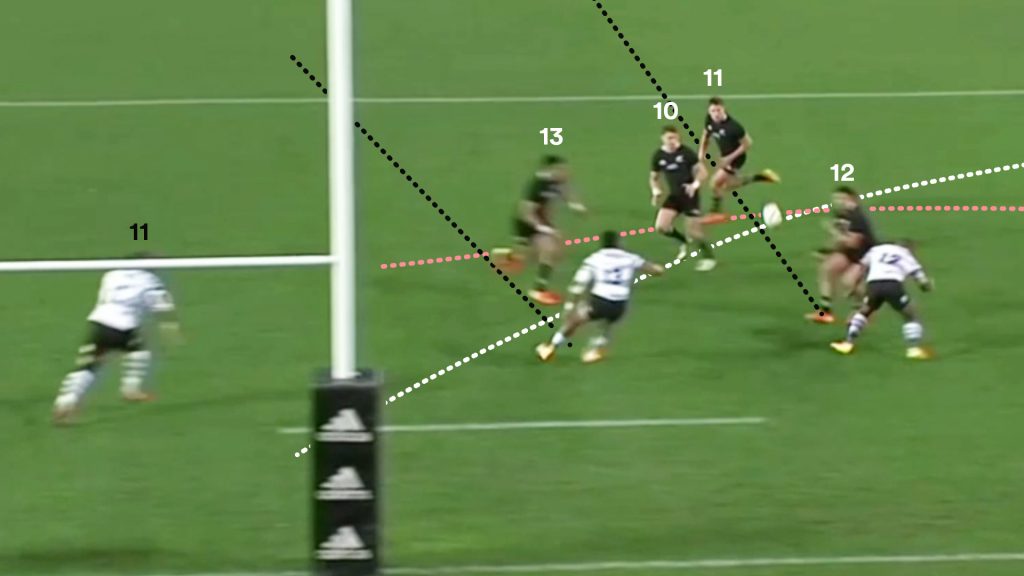
Rieko Ioane (13) running across the face of Fijian centre Waisea Nayacalevu with Barrett (10) and Bridge (11) in motion around the back creates indecision, freezing the defender.
The All Black centre did his core job well despite playing a supporting role. He is there to hold the defence or take a flat short ball from Havili if the defence looks interested in the sweepers out the back.
Barrett and Bridge timed their lines well, staying inside Ioane even as the pass is released.
Although Nayacalevu did not fully commit to Ioane, he sat down on the spot to hedge his bets. With his momentum lost as a result, he had to move from a standing start. Barrett (10) and Bridge (11) in motion at speed have him beat.
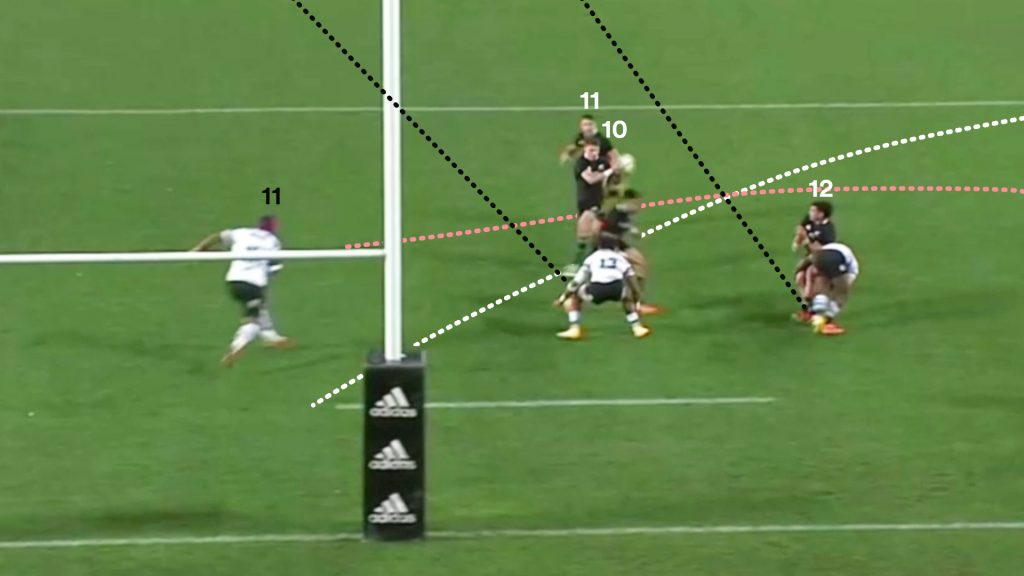

Barrett (10), feeling the rush from Nemani Nadolo (11), plays an early pop pass to Bridge knowing the big Fijian can’t change angle at that speed to cover him. From that point it was like dominos, as the ball moved past each collapsing Fijian defender.
Jordie Barrett (15) took the last pass from Bridge (11) and ultimately scored untouched. Short, sharp handling with great timing is too much for the Fiji defence, with every All Black nailing their job in the sequence.
It starts with Aaron Smith’s ability to fire a long, direct pass to Havili from a running start and ends with Bridge’s quick hands to free his fullback.
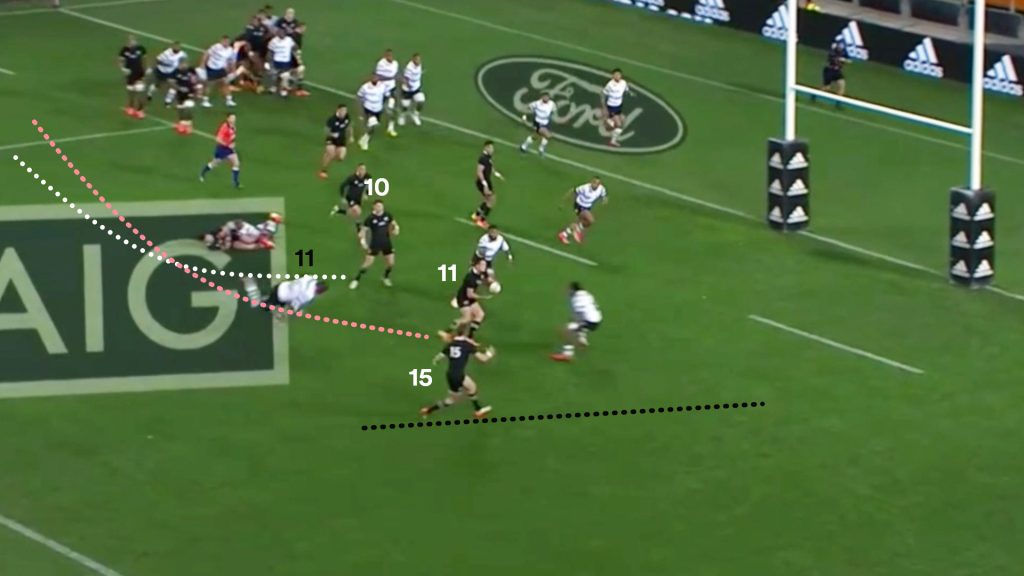
The All Blacks use the same play later in the half on Havili’s second try, this time from the opposite side going right-to-left with Sevu Reece (14) on the sweep line instead of Bridge.
This is where we see the diversity in Havili’s game, and how he is able to manufacture a one-on-one match-up for himself with his ball-handling skills.

There is sleight of hand in the way Havili approaches the Fijian line, with outstretched hands feigning the pass again out the back to Beauden Barrett (10). It is natural hand movement in sync with Havili’s half-goose step, which he uses here.
It has the effect of promising the pass just slightly, keeping the outside defender from closing in and giving the second five one-on-one alignment.

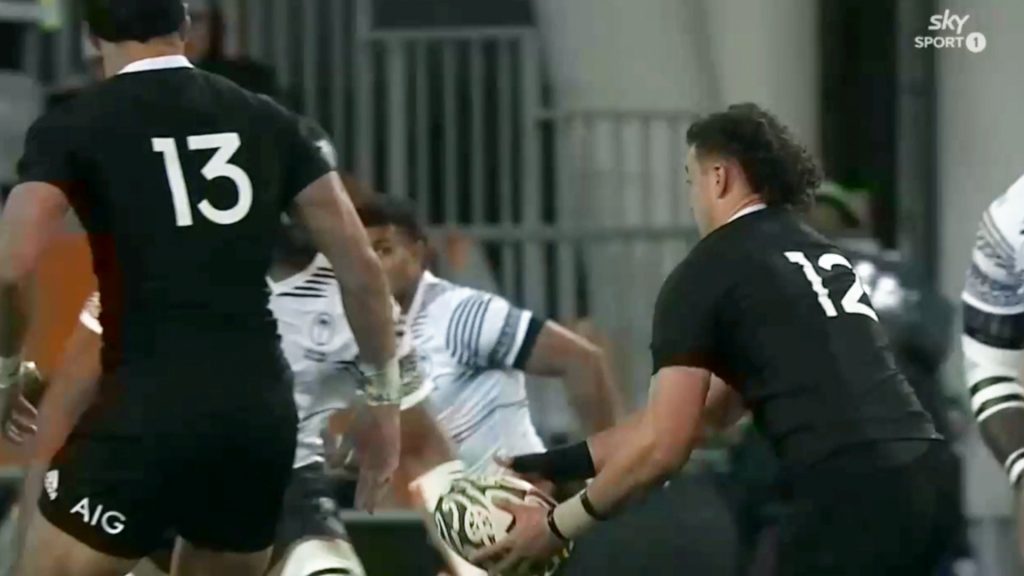
Although the assignment was not a mismatch by any means, it was openside flanker Mesulame Kunavula, it is better than getting sandwiched in a two-man tackle.
With a one-on-one chance, Havili breaks Kunavula’s tackle and ends up slicing through the front line to score next to the posts.
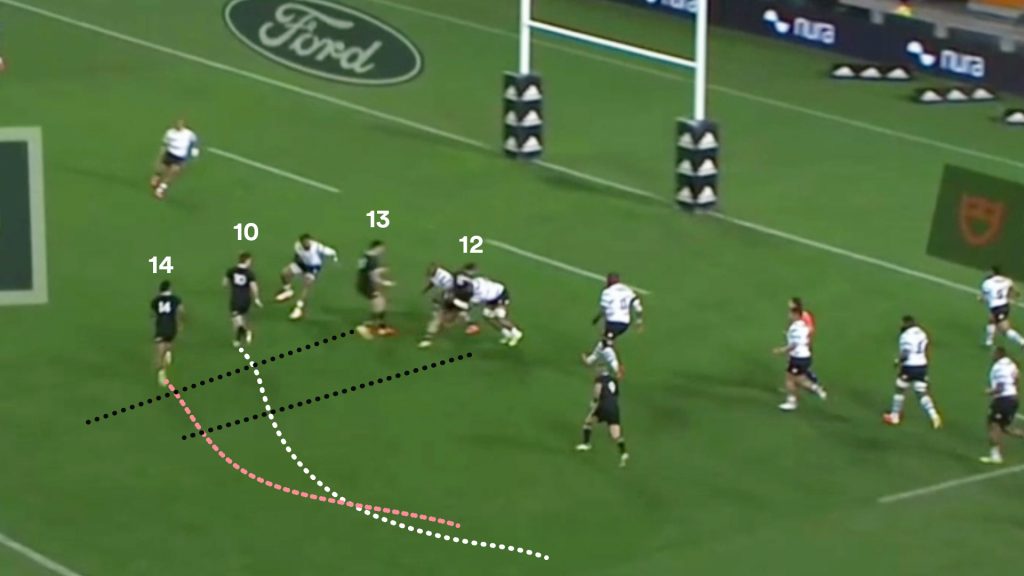

The midfield launch patterns were simple also, again playing with the flat set-up that Foster likes, this time with wide spacing between each man.
The below is a common All Blacks formation, using the flat midfield set-up and sweeping winger as an option out wide if needed.
Using Beauden Barrett’s pass to dictate play, the All Blacks’ 10 has three options, Havili (12) short, a miss pass to Ioane (13), or Reece (14) directly out the back.
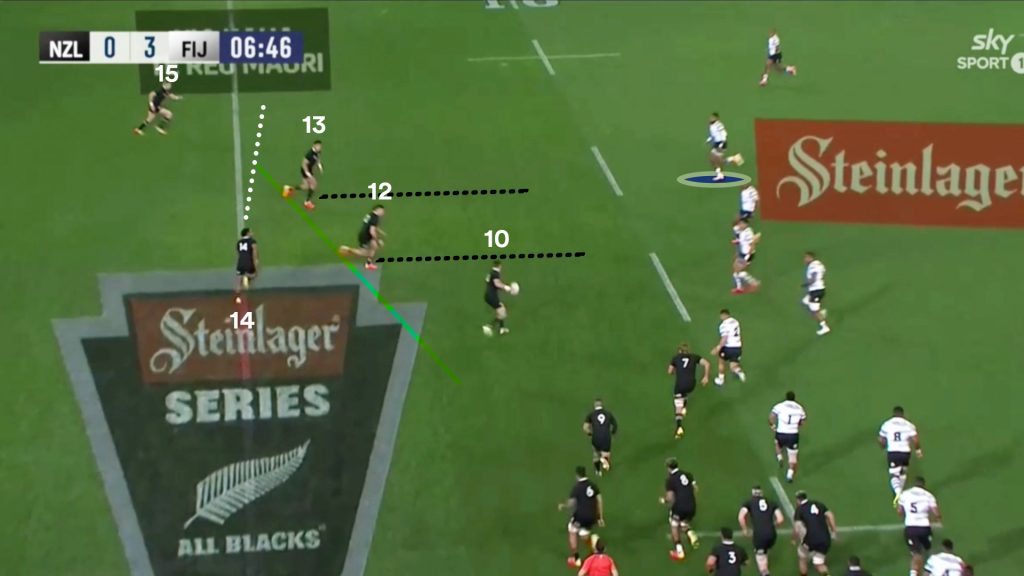
Off the miss pass to Ioane, he also has options to keep the play moving. One variation they like to run is a screen or ‘pick’ play to seal the edge with Jordie Barrett (15) running flat and Sevu Reece coming around the corner.
It is shown here against Ireland in the quarterfinal of the 2019 Rugby World Cup, where Mo’unga throws the miss pass to centre Goodhue before they run the screen on the edge to free Reece coming around the corner.
From this base formation against Fiji in midfield zones, Barrett often gave Rieko Ioane early ball to try and make something happen out wide, but it often resulted in Ioane going to ground with ball in hand.

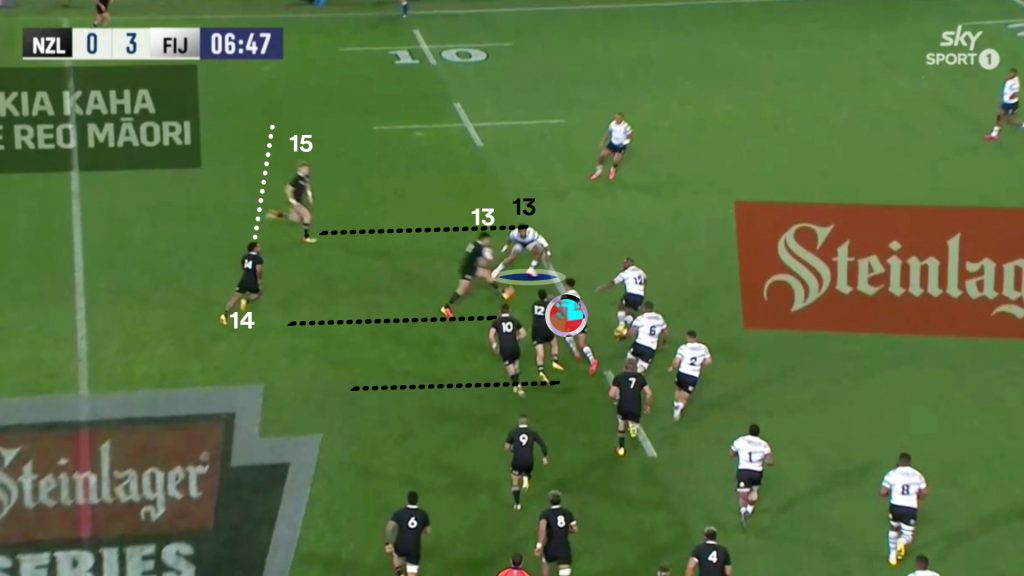
He often found the gain line but couldn’t break the tackles of what was a strong Fijian midfield. The option to find an offload wasn’t explored which could have potentially set Jordie Barrett free on this occasion.
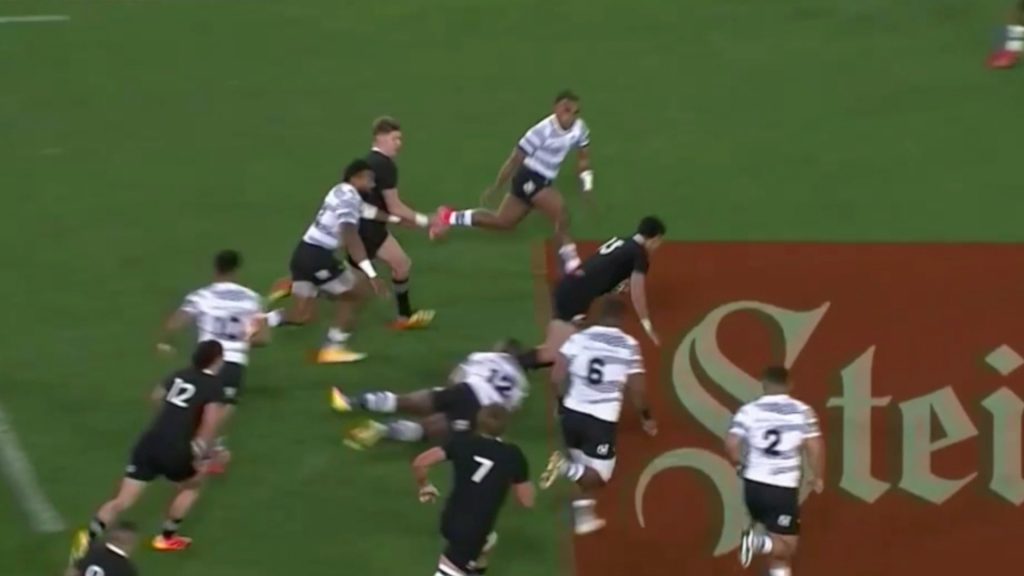
It was a similar story later in the match.
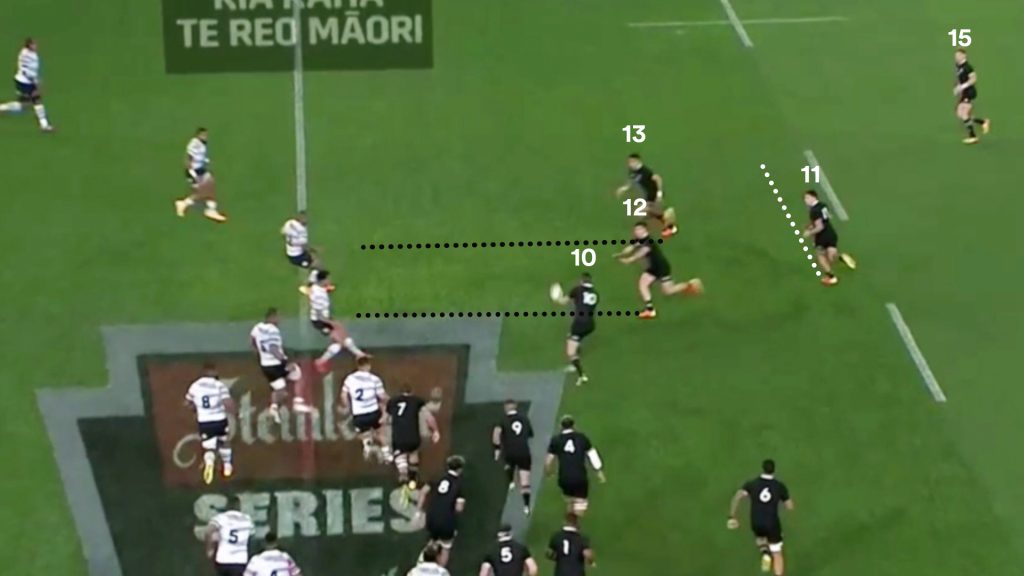

These midfield launches often lacked real threat, either on the first phase or thereafter. The All Blacks tried working the same way after the wide carry from Ioane, but the execution let them down or the defence was up to it on the third phase.
It often resulted in the All Blacks raising the white flag and putting in a kick for territory or high ball.
Barrett tried using Bridge out the back on one occasion, but again it resulted in a one-out carry that threatened to become a turnover once Bridge was isolated with no support.
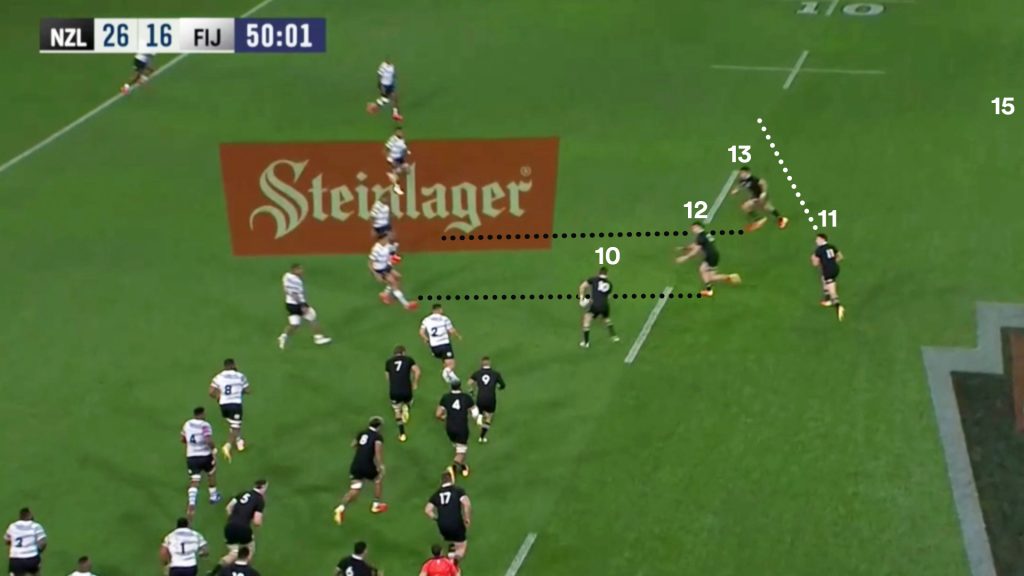
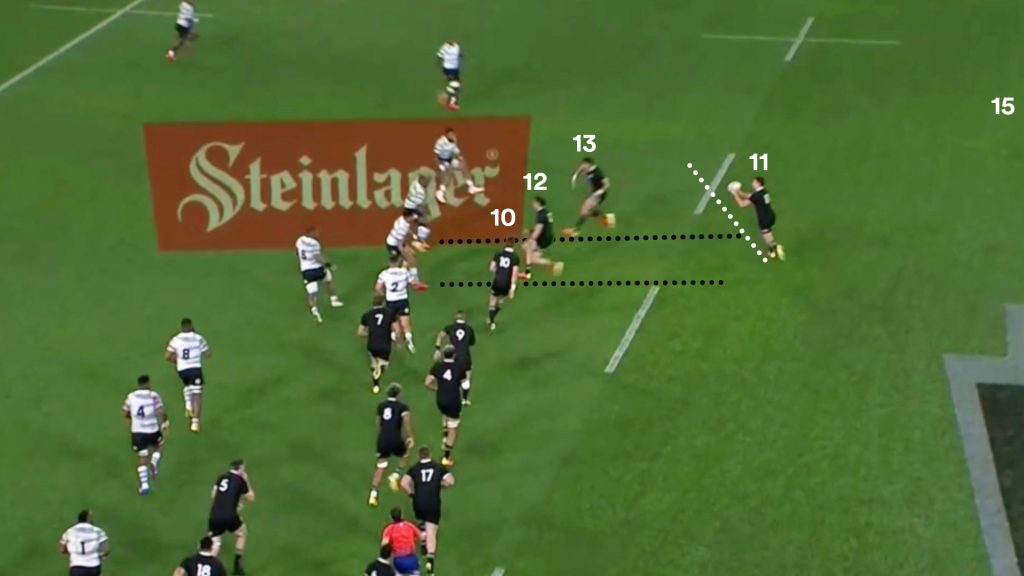
The All Blacks didn’t reveal too much from this formation and kept the more complex variations under wraps, perhaps an area that can be expanded in the second test to ask more questions of the Fijian defence.
One of the ‘specials’ from the line out that did pay off early in the second half was a three-phase pattern that brought play back down the blind side. After a deliberate overthrow and a forward carry around the corner, the All Blacks switch play back with this look.
The Fijians are left thin on the short side as the All Blacks attack with two playmakers, Barrett and Havili, coming from depth behind two forwards in two separate stacks.

The ball is moved quickly to the second stack by Shannon Frizell, where Codie Taylor links with Havili coming around the edge at speed to take advantage of the space out wide.
Having played for years at fullback for the Crusaders, Havili found himself in a two-on-one situation very familiar to what he would find as a 15 and made no mistake drawing the cover defence and gifting the last pass to Bridge for a walk-in try.


It was another example of Havili’s versatility in attack which gave the All Blacks ball movement more fluency with a 12 capable of distribution and ball-playing with a rounded passing game. Even on this set-piece play, they were able to scheme a play effectively using him as a fullback.
His smooth combinations with his Crusaders teammates were on show here, from Codie Taylor to Havili through to Bridge without a hitch.
The area of the game that the All Blacks promised so much but couldn’t quite deliver on was their counter-attacking chances.
It was typical in the approach on the fast dry track in Dunedin, utilising quick line out throws and spreading the ball to the edge quickly after winning turnovers, but they couldn’t quite find the level of execution required to make Fiji pay.
On a Brodie Retallick steal inside their own half, they spread it through the hands to Ioane (13) on the right hand side. Ioane commits the last man with Barrett (10) and Bridge (11) in open space outside him, but Barrett spills the ball and bombs the opportunity.
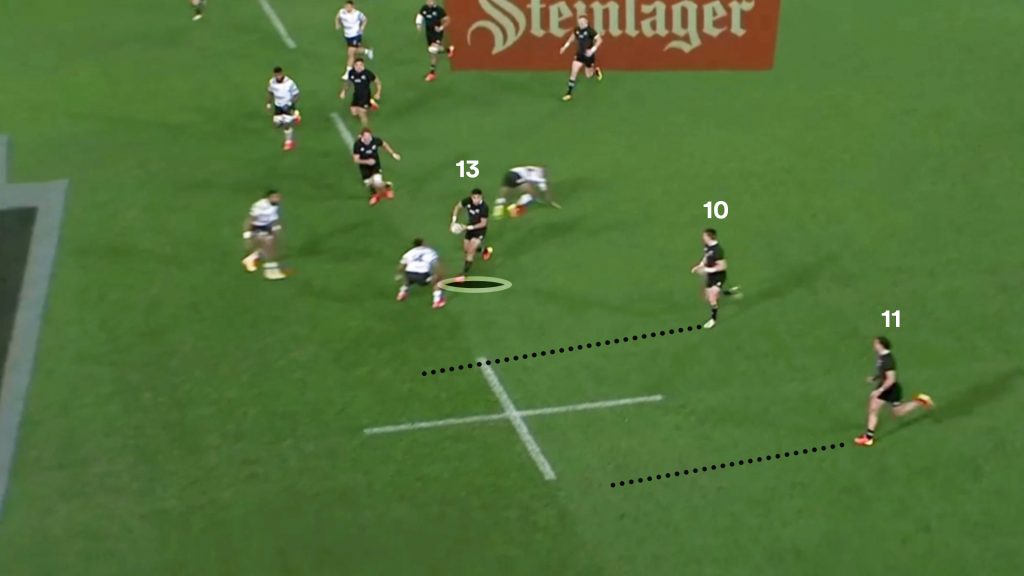
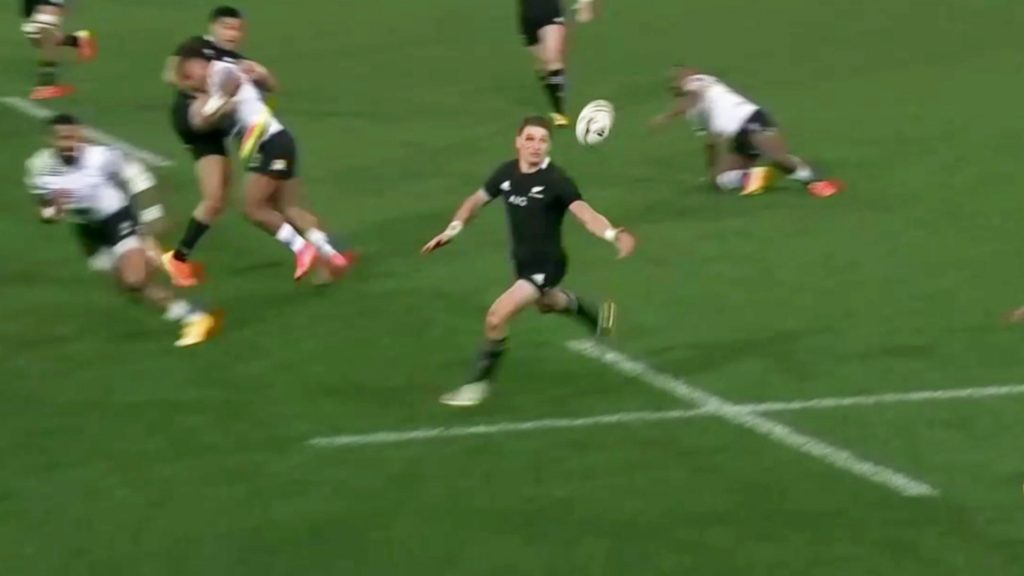
Barrett’s busted eye may have hindered his sight on this occasion but it was a missed chance that became a common sight on the night.
On the other side of the field, Ioane tries to link with Jordie Barrett, who was expecting the pass to go directly to Reece. The ball hits the turf and the opportunity goes to waste again.

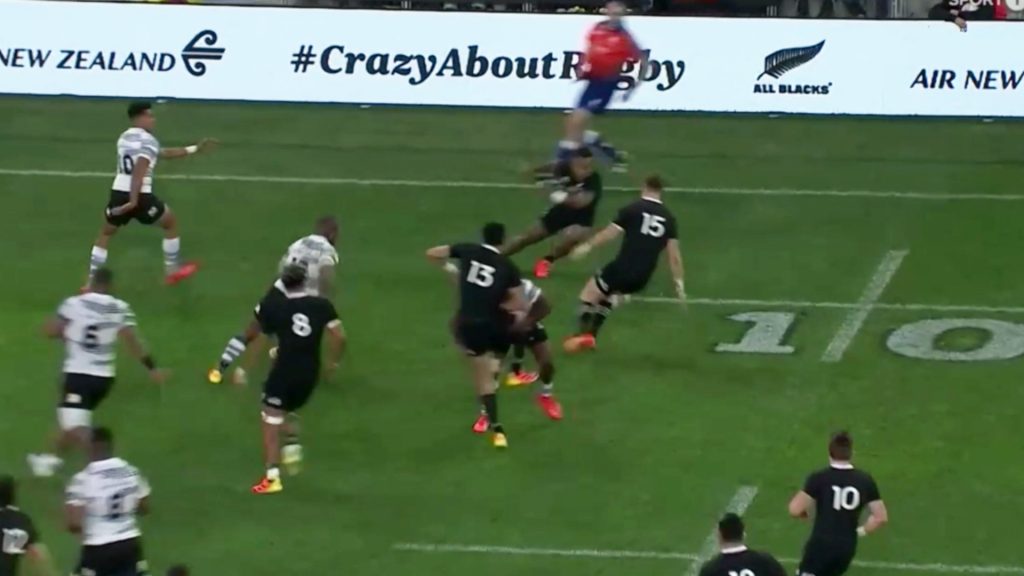
Shortly thereafter, after a long break down the middle of the field from a kick return by Reece (14), Tuipulotu misses a chance to offload to a flying Jordie Barrett in support with an open line in front.
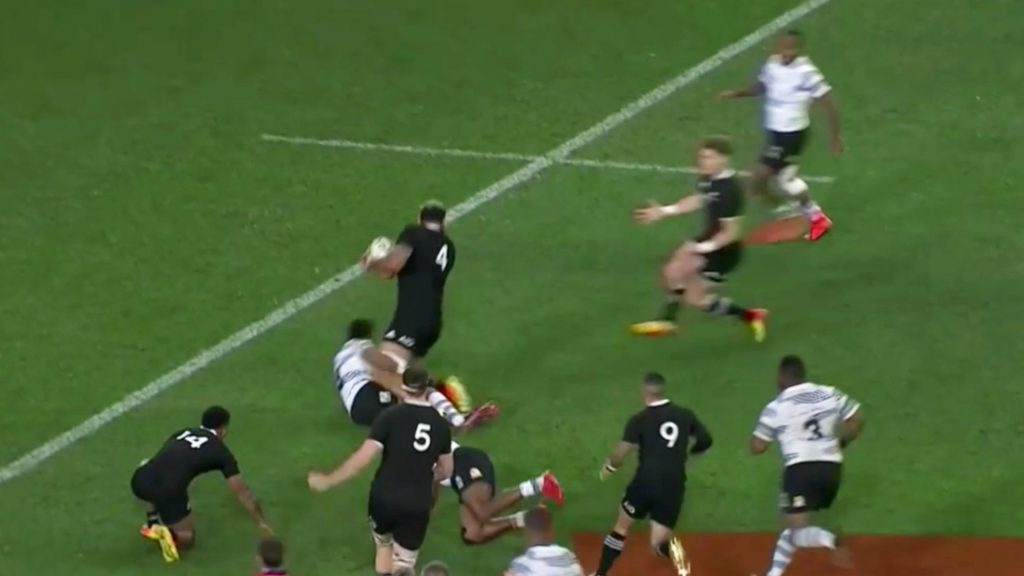
He is able to get up and keep playing, shifting the ball to Ethan Blackadder on the wing but Fiji scramble and stop the All Blacks from scoring on that play. They maul it over from a penalty a few moments later, but against stronger opposition they may not be able to.
The All Blacks were able to beat Fiji thoroughly through clinical set-piece execution, but tougher opposition will bring better decision-making and spacial coverage in defence eventually and such prolific scoring rates from those platforms will decline.
When the All Blacks start capitalising directly on click plays it will be a sign that they are back to their best and most ominous form. At the moment their are growing pains with their free-flow attack, perhaps expected with so many positional changes and inexperienced players.
David Havili’s performance in attack was a highlight, as was some of the back line play that did look sharp. Beauden and Jordie Barrett at 10 and 15 possess natural chemistry, and both linked well with the Crusaders Havili, Bridge, and Reece.
Ioane had touches that just didn’t seem to gel with the others, but when he had to play a supporting role, such as running a good dummy line, he performed it well. If he can continue to grow in the role, they will hopefully find the connections that can unlock the potential Ioane has as a centre as it just isn’t all there at the moment.
As Foster has indicated these July tests are auditions for The Rugby Championship, more rotation is to come so we may not see the All Blacks find their complete rhythm until then.



Comments
Join free and tell us what you really think!
Sign up for free